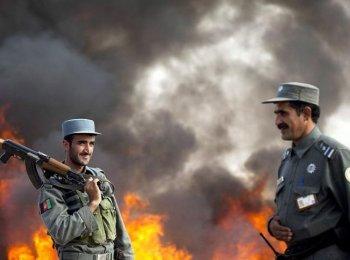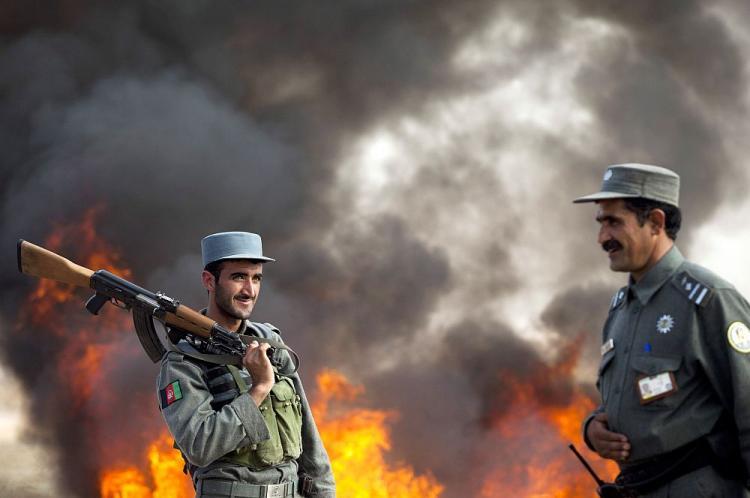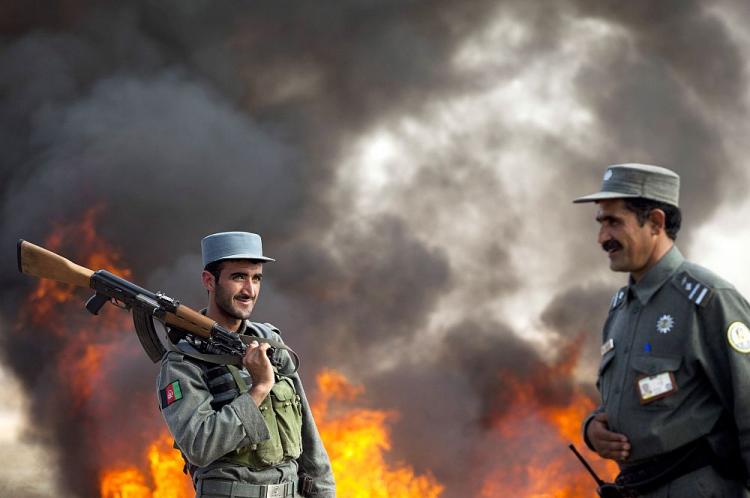Napolitano toured the Torkham border crossing with Pakistan on the second day of her Afghanistan visit on Dec. 31, and securing the Afghan borders was a key topic of her meeting with Afghan President Hamid Karzai on Jan. 1.
The Afghan-Pakistan border, also called the Durand Line, stretches 1,640 miles with deserts to the south and mountains to the north. The area “is a region of particular security concern,” due to rival tribes on either side of the border, and “a quarter of the drugs produced in Afghanistan pass easily through Pakistan’s border areas,” according to a report from The National Bureau of Research (NBR).
Last year, the Department of Homeland Security (DHS) began increasing operations to crack down on shipments of opium, chemicals for explosives, and other illegal materials at Afghan borders.
The DHS is trying to set up a stronger border security and customs system in Afghanistan. “Building and maintaining a strong border crossing system is critical to the stability and security of Afghanistan,” said Napolitano in a press release.
Six officials arrived with Napolitano at the Torkham border on Dec. 31. They will add to the more than a dozen U.S. Customs and Border Protection (CBP) officers and U.S. Immigration and Customs Enforcement (ICE) agents who are training the Afghan government on securing the border, according to a Department of Homeland Security (DHS) press release.
Additional agents will be sent to the country in the coming months, according to the press release.
There are some major obstacles in tackling the drug trade across the Afghan-Pakistan border, with corruption near the top of the list.
On the Pakistan side of the border, the government “has demonstrated a nascent ability in dealing with cross-border security issues and in protecting supply lines,” yet there are “problems with cooperation between military and security forces for providing contract convoy protection,” according to a report from the Royal United Services Institute (RUSI), a defense and security think tank.
Even so, Pakistan is far ahead of Afghanistan when it comes to border security. While Pakistan “has established numerous border posts, in the process capturing and neutralizing significant numbers of al-Qaeda and Taliban militants, and interdicting a large amount of narcotics,” the Afghan army and police force “remain incapable of cross- border reciprocity,” states the report.
Illicit Trade
The Afghan-Pakistan border is a sensitive spot. “A variety of regional tensions and festering problems—some of which date back decades— converge today on the Afghanistan-Pakistan border,” states the NBR report.
It states, “A multitude of actors are deeply involved in Afghanistan’s opium poppy production, including the Taliban, all levels of the Afghan government, law enforcement, unofficial power brokers, and tribal elites.”
The area is a key area for the “narco-jihad,” a nickname given to the use of drug trade by terrorist groups both as a source of funding and as a way to weaken governments.
The narco-jihad “increases the chances that the insurgency will be prolonged while also strengthening the major players in the narco-trade system,” which then “ensures that the central government of Afghanistan remains weak,” according to the NBR report.
Afghanistan is the source of 90 percent of the world’s opium, much of which is smuggled across the Pakistani border. Afghanistan is also the second largest producer of cannabis resin, with other contraband including illegally harvested timber, antiques, and counterfeit cigarettes, according to the report.
The Afghan drug trade plays a significant role in countering U.S. efforts to weed out corruption from the local government. It has also disrupted training of the Afghan military and police force, as drug abuse is prevalent among the Afghan security forces.
“Drug abuse continues to be a problem for the Afghan army and police,” states a report from the office of the special inspector general for Afghanistan Reconstruction, dated June 29, 2010.
“As of February 2010, results from drug tests during a personnel asset inventory of the Afghan police force overall showed positive results for drug use in 17 percent of police tested,” the report states, adding that in one extreme case, an Afghan unit of 100 police officers were openly using marijuana “and were unwilling to conduct operations or even leave their compound.”




![[LIVE Q&A 04/30 at 10:30AM ET] Major Government Policy on the Internet Passed](/_next/image?url=https%3A%2F%2Fimg.theepochtimes.com%2Fassets%2Fuploads%2F2024%2F04%2F29%2Fid5640068-CR-TN_REC_0430-1080x720.jpg&w=1200&q=75)


